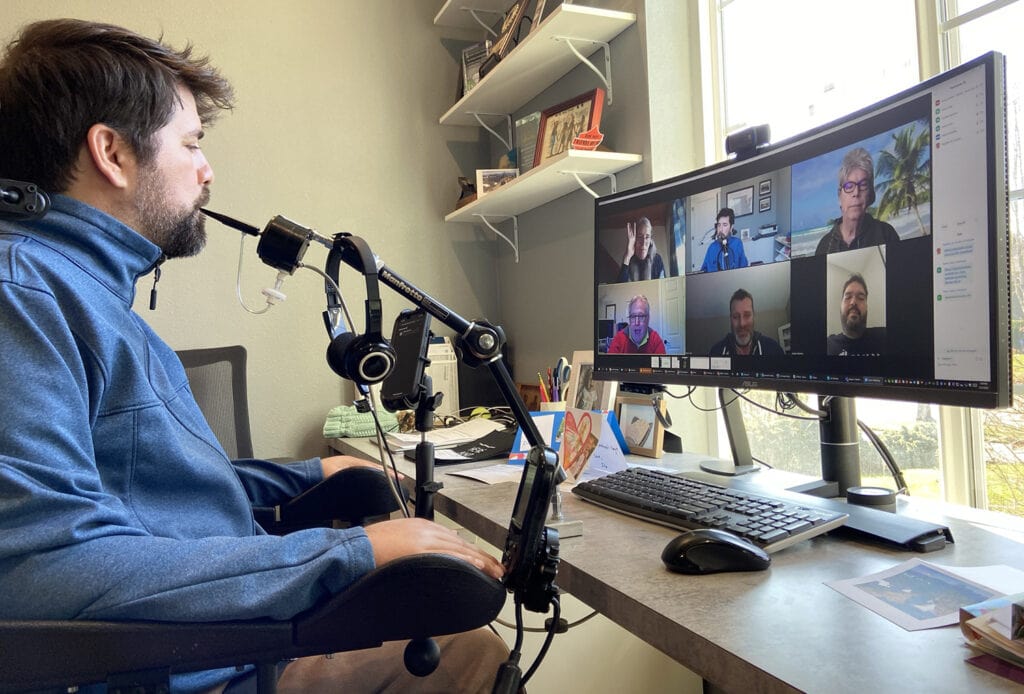
Whereas the pandemic gave the rest of the world a glimpse of what it can be like to live with paralysis — isolated, disoriented and awaiting an elusive cure — it literally added insult to injury for those newly diagnosed. As the co-founder and president of the Here and Now Project, Washington state’s chapter of United Spinal Association, I saw this firsthand.
The need to isolate and quarantine meant already-shortened rehab stints were even less effective than usual at preparing the newly paralyzed and their families for life outside the hospital walls. With recreational therapy being put on hiatus or discontinued, visitations being slashed, and an absence of in-person peer support, the disconnect between those new to the game and the organizations that serve them grew.
After years hosting social gatherings primarily at libraries and pizza joints all over western Washington, H&NP had just begun to make substantial headway in our outreach efforts by hosting our first in-house support meeting at Harborview Medical Center in March 2020, when the pandemic shut everything down. The visitation embargo completely undercut our newly launched Care Basket program, and we had to pivot all our in-person programming to virtual almost overnight.
The silver lining of the virtual space revealed itself rather quickly, mainly how it allowed us to reach individuals we previously could not have connected with via our in-person get-togethers. For the many people without access to reliable and independent transportation, reliable internet access became a much lower bar to connecting. Meeting attendance swelled, with folks from Idaho, Alaska and beyond able to check in. Our quarterly educational forums went from fewer than 10 attendees in person to 30 or more online.
Rob Gibbs sustained a C5-6 incomplete injury as a result of spinal stenosis surgery in 2020. Gibbs, 65, was transferred to a skilled nursing facility that ended up being ground zero for COVID-19 in Washington state. Sequestered in his room, with sporadic visitors only allowed to visit from outside his window, Gibbs leaned heavily on our rotating calendar of virtual options to find connection and support. “I was quite depressed because I couldn’t leave the facility, nor could my family physically come in and spend time with me,” he says. “Without an online presence, I never would have been encouraged by my newfound friends.”

While that transition to virtual programming was fairly simple thanks to the timely emergence of Zoom, Google Meet and other social meeting platforms, there was still a significant dimension of support that was lost without the in-person connections that our peer fellowship was built upon. The hands-on mobility tips, equipment hacks and spontaneous side conversations that happen naturally between attendees when they get knee-to-knee are hard to replicate when you’re mostly seeing people from their chest-up on a gallery of screens.
The return to in-person programming has been a challenge, complicated by the medical fragility of the community we serve. A sizable cross section of our membership remains hesitant to reengage in our weekly gatherings for fear of getting sick, with many choosing to pick their battles by attending only the larger annual events and outdoor get-togethers.
The handful of monthly meetings we’ve held in person have had limited participation, and our Annual Paralysis Meetup and Resource Expo’s return saw attendance dip 20-30% from 2019 numbers, after being held online for two years. The convenience of a Zoom call often trumps loading up into a vehicle and trekking to and from in-person gatherings. Hybridizing support meetings has also proven to be a challenge without dedicated tech support to ensure seamless interaction between live and online attendees.
What remains to be seen is not a question of how long it will take to return to pre-pandemic peer support efforts, but if we ever fully will. We continue to make inroads with the various hospitals in the region in lieu of direct peer support, utilizing the occasional rec therapy consult and inpatients’ limited visitations to start bringing care baskets and adaptive water bottles.
Gibbs, who recently joined the H&NP board, appreciates how critical it is that we successfully adapt to the new reality. “It is such a vital time trying to navigate this new physicality, and peer support continues to be so important.”
Support New MobilityWait! Before you wander off to other parts of the internet, please consider supporting New Mobility. For more than three decades, New Mobility has published groundbreaking content for active wheelchair users. We share practical advice from wheelchair users across the country, review life-changing technology and demand equity in healthcare, travel and all facets of life. But none of this is cheap, easy or profitable. Your support helps us give wheelchair users the resources to build a fulfilling life. |


Recent Comments
Bill on LapStacker Relaunches Wheelchair Carrying System
Phillip Gossett on Functional Fitness: How To Make Your Transfers Easier
Kevin Hoy on TiLite Releases Its First Carbon Fiber Wheelchair